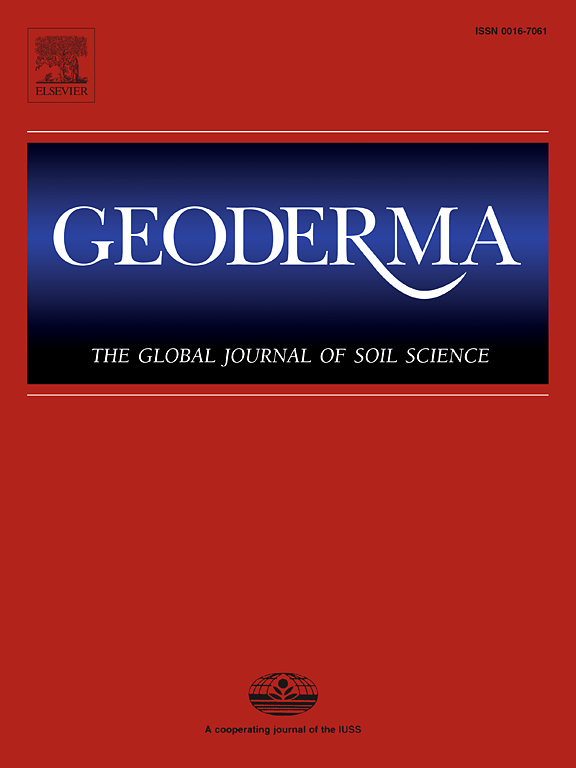探索西藏草原土壤碳、氮、磷和酸碱度时空稳定性的动态变化
IF 6.6
1区 农林科学
Q1 SOIL SCIENCE
引用次数: 0
摘要
人类活动和气候变化对陆地生态系统时间稳定性的影响仍存在争议。本研究探讨了2000-2020年间西藏草原0-10厘米、10-20厘米和20-30厘米土壤有机碳(SOC)、全氮(TN)、全磷(TP)及其比值(C:N、C:P、N:P)和pH值的时空变化规律和驱动机制。土壤变量时间稳定性相对变化的空间平均值为-19.78%至-6.85%。相比之下,31.39%-45.98%的草原地区土壤变量时间稳定性的相对变化有所增加。在 31.50-44.07% 的草原区,气候变化主导了土壤变量时间稳定性的变化。同时,55.35%-68.43%的草原区主要受人类活动的影响。与降水变化和气候变暖相比,辐射变化对 0-10 cm 的 SOC、TN、TP、C:N 和 C:P,10-20 cm 的 SOC 和 TP,以及 20-30 cm 的 TN 和 C:N 的时间稳定性的相对变化影响更大。土壤变量本身与其时间稳定性并不总是正相关,甚至可能是负相关。土壤变量时间稳定性的相对变化与土壤变量的相对变化并不总是负相关,甚至是正相关。因此,气候变化与人类活动的相互作用会使土壤变量时间稳定性的空间分布同质化或异质化。这些土壤变量的时间稳定性总体下降,局部上升。人类活动引起的土壤变量时间稳定性变化面积大于气候变化引起的变化面积。辐射变化对土壤变量时间稳定性时空格局的影响值得重视。土壤变量的相对变化与土壤变量时间稳定性的相对变化之间并非总是存在权衡关系。本文章由计算机程序翻译,如有差异,请以英文原文为准。
Exploring spatiotemporal dynamics in temporal stability of soil carbon, nitrogen, phosphorus, and pH in Tibetan grasslands
Effects of human activities and climate change on temporal stability of terrestrial ecosystems remains controversial. This study explored the spatiotemporal patterns and driving mechanisms of the temporal stability of soil organic carbon (SOC), total nitrogen (TN), total phosphorus (TP), their ratios (C:N, C:P, N:P), and pH at 0–10 cm, 10–20 cm, and 20–30 cm in the Tibetan grasslands during 2000–2020. Spatially averaged values of relative changes in temporal stability of soil variables ranged from –19.78 % to –6.85 %. In contrast, the relative changes of temporal stability of soil variables were increased for 31.39–45.98 % grassland areas. Climate change dominated changes in the temporal stability of soil variables in 31.50–44.07 % of grassland areas. Meanwhile, human activities predominated changes in 55.35–68.43 % of it. Compared to precipitation change and warming, radiation change had stronger effects on relative changes of temporal stability of SOC, TN, TP, C:N and C:P at 0–10 cm, SOC and TP at 10–20 cm, and TN and C:N at 20–30 cm. Soil variables themselves were not always positively correlated with their temporal stability, and may even be negatively correlated. Relative changes of temporal stability of soil variables were not always negatively but even positively correlated with relative changes of soil variables. Therefore, the interaction of climate change and human activities can homogenize or heterogeneize the spatial distributions of temporal stability of soil variables. The temporal stability of these soil variables overall decreased, with local increase. The areas of the change of temporal stability of soil variables caused by human activities were greater than those of climate change. Effects of radiation change on the spatio-temporal patterns of temporal stability of soil variables should be underlined. There were not always trade-off relationships between relative changes of soil variables and relative changes of temporal stability of soil variables.
求助全文
通过发布文献求助,成功后即可免费获取论文全文。
去求助
来源期刊

Geoderma
农林科学-土壤科学
CiteScore
11.80
自引率
6.60%
发文量
597
审稿时长
58 days
期刊介绍:
Geoderma - the global journal of soil science - welcomes authors, readers and soil research from all parts of the world, encourages worldwide soil studies, and embraces all aspects of soil science and its associated pedagogy. The journal particularly welcomes interdisciplinary work focusing on dynamic soil processes and functions across space and time.
 求助内容:
求助内容: 应助结果提醒方式:
应助结果提醒方式:


